Note: If an image ever fails to appear - refresh your page, it really is there
Flags of the World War I Era
| Earlier Wars | Flags of the Central Powers | Flags of the Allies |
Wars leading to World War I
Three smaller wars led up to World War I. They were the Austro-Prussian War (1866), the Franco-Prussian War (1870-1871), and the Russo-Japanese War (1904-1905). The first two allowed Prussia to become the dominant German State, and eventually form the Second Reich (Empire). The Russo-Japanese War resulted in the world discovering the growing power of Japan in Asia and the weakness of Imperial Russia.
The Austro-Prussian War or Seven Weeks War 1866
The Austro-Prussian War or Seven Weeks War was a short war fought between June and August of 1866, between Prussia (allied with Italy), and Austria (allied with Bavaria, Württemberg, Saxony, Hanover, Baden, and several other smaller German states). Prussian Chancellor Otto von Bismarck had deliberately provoked the war, over the objections of his king, as a step toward the unification of Germany under Prussian dominance. The war resulted in a strong Prussian-led North German Confederation.
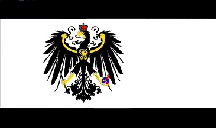
Kingdom of Prussia
|
Kingdom of Prussia Flag
With an efficient military machine Prussia (allied with Italy) overran the German states allied with Austria and crushed the Austrians at the Battle of Sadová. The Seven Weeks War paved the way for the establishment of the German Empire in 1871 and the formation of the Austro-Hungarian Empire in 1867. |
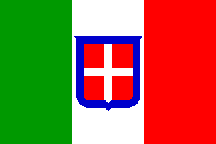
Kingdom of Italy
|
Kingdom of Italy 1848-1946
There is not any agreement regarding the meaning of the colors of the Italian flag . However the most valid hypothesis is that the colors came from the colors of the uniforms of the Civic Militia of Milan. These were green and white and some red parts were added in 1796 when the Militia become the National Guard. In 1848, the tricolor, charged with the shield in the center, became the national flag of the Kingdom of Sardinia and, in 1861, for the Kingdom of Italy.
|
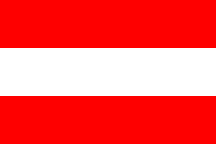
Austrian Flag
|
Austria National Flag
The origin of the Austrian colors dates back to the Battle of Acre in 1191. According to legend Duke Leopold V fought so hard that his battle-bloodied tunic only remained white where it was covered by his wide belt. Losing his standard during the battle, Leopold supposedly raised his tunic as a rallying point, and the red/white design subsequently became the national colors of Austria. The Crest of Hungary would later be added to the Austrian Flag.
|
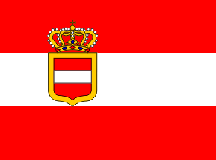
Austrian Naval Ensign
|
Austrian Naval Ensign 1786-1915
The Austrian Empire (known as the Austro-Hungarian Empire or the Dual Monarchy after the constitutional reforms of 1867) was never a major sea power, although since the eighteenth century it had maintained a small, but efficient navy that used this ensign on its warships.
|

Austrian Merchant Ensign
|
Austrian Merchant Ensign 1730-1915
The most commonly seen flag of Austria was the Austrian Merchant Ensign, introduced around 1730. This is the "national" flag most commonly used later in Imperial German propaganda posters and illustrations to represent both Austria, and the Austro-Hungarian Empire. It actually was also the most internationally recognized Austro-Hungarian flag up until the Dual Monarchy was dissolved at the end of World War I. Although, the merchant flag was "officially" replaced in 1869, it remained in common use up until 1915.
The Austrian Merchant Ensign evolved from the traditional Black-yellow Landesfarben (land colors) of the Habsburg-Lorraine Dynasty. Because of this Austria-Hungary was often referred to as the "black-yellow monarchy." |
The Franco-Prussian War 1871
A major event in German history was the defeat of France in the Franco-Prussian War in 1871, making Germany a world power. It was during this war that, in 1870, Prussian Prime Minister Otto von Bismarck orchestrated the unification of the German states.

French Tricolor
|
Second French Empire 1852-1871
The nephew of Napoleon I, Louis Napoleon, was elected President of the Second French Republic in 1848. In 1851, he overthrew the Republic and became Napoleon III, Emperor of the Second French Empire. The Franco-Prussian War brought an end to the 29 years of the Second Empire. Since the first French Revolution the tri-colors has been the only official French Flag.
|
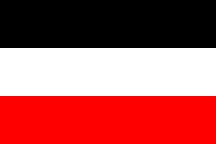
Imperial Germany
|
The Second Reich 1888-1918
The German Empire was established under Prussian leadership with Bismarck as Chancellor. Wilhelm II, the last of the Hohenzollern dynasty, became Emperor of Germany (Kaiser) in 1888 and ruled until Germany's defeat in World War I.
To learn more about the personal flags and standards of the German Emperors of the Second Reich ( Click Here )
|
The Russo-Japanese War 1904-1905
The Russo-Japanese War began in February of 1904, when the Japanese launched a surprise attack on Russian naval vessels at Port Arthur in China. This war marked the first time an Asian power defeated a European power in modern times, and established Japan as a major force in world affairs.
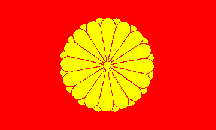
Imperial Japan
|
The Imperial Japanese Flag
The flags of Japanese Royalty incorporate the Imperial arms, namely the sixteen petal chrysanthemum. Aside from its golden color, the flags utilize the national colors of red and white.
|
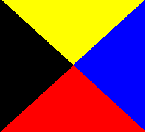
Japanese Z Flag
|
The Japanese "Z" Signal Flag
Admiral Heiachiro Togo hoisted the Z flag aboard his flagship Mikasa immediately before engaging Admiral Rozhestvensky's Russian fleet at Tsushima Straits on May 27, 1905. The meaning of the signal meant, in substance, "The fate of Imperial Japan hangs on this one battle; all hands will exert themselves and do their best." The Z flag was also used by the Japanese Fleet that attacked Pearl Harbor in 1941.
This is an international signal flag, not just Japanese.
|

Japanese National Flag
|
Japanese National Flag 1870-present
The chrysanthemum of the Imperial Flag was replaced by the famous red sun symbol on the national flag and the red field turned to white. The Japanese national colors are red and white. It is said that at the time of the Mongol Invasions of Japan (1274 and 1281) the priest Nichiren presented a similar sun flag to the shogun. The shogun adopted the flag for all his ships in the early 1600s. In 1870 the Meiji government officially designated it for use on Japanese merchant and naval ships.
|
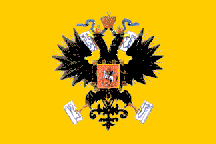
Flag of the Czar
|
The Russian Imperial Flag 1699-1917
The golden flag with black Romanov coat of arms holding 4 scrolls was used between 1699 and 1917 as the personal flag of the Russian Czar. This flag symbolized the union of the Czar and his people.
In 1917, a plain white, blue, and red striped flag was designed by Nicolas II as replacement to the Romonov Imperial Flag (See "Imperial State Flag - Type 1" under Flags of the Allied Powers below).
|

Russian Navy
|
The Flag of Russia 1812-1841
This flag with the light blue Cross of St. Andrew on a field of white was called "The Flag of Russia." It served as the Russian naval ensign for the Imperial Russian fleet.
This flag with its simple Saint Andrews Cross design has a long and interesting history and re-appeared both as the Russian Liberation Flag (ROA) during World War II and once again is being used as the Russian Naval Ensign. |
| Earlier Wars | Flags of the Central Powers | Flags of the Allies |
Flags of the Central Powers
Imperial Germany - Austro-Hungarian Empire - Ottoman Turks

Imperial Tricolor Flag
|
Imperial German Tricolor 1892-1918
The black-white-red striped German imperial flag was adopted by the North German Confederation in 1867, as a combination of the black-white of Prussia and the red-white of Brandenburg. In 1871 it was adopted as merchant flag for the German Empire, and in 1892 declared to be the national flag of the Second Reich and continued in use until 1918. It was briefly reintroduced later just prior to World War II between 1933 and 1935, and used jointly with the Nazi swastika flag, then banned as "reactionary."
To learn more about the personal flags and standards of the German Emperors of the Second Reich ( Click Here )
|
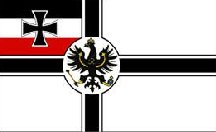
Imperial War Ensign 1813
|
Imperial War Ensign 1867-1892
This naval war ensign was used from 1867 to 1892 by both the German Confederation and the Second Reich at sea. It had a white field, a black and white cross, and a small black-white-red flag with a black Iron Cross in the canton.
The Iron Cross was a Prussian order first established by King Frederick William III in 1813 for military valor or patriotic service in the 1813-15 war against Napoleon. It was revived in 1871 for the Franco-Prussian war and in 1914 for the First World War. It was also revived as a German order in 1939 by Hitler.
( Click here to learn more about the history of the Imperial War Flag 1867-1921 ) |
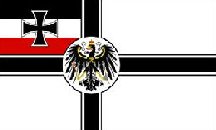
Imperial War Ensign 1892
|
Imperial War Ensign 1892-1903
This was the German War Flag used from 1892 to 1903. It was changed when the Germany army began to use this flag as a war flag on land. After Wilhelm II succeeded to the Second Reich throne in 1888, this flag, with its redesigned Prussian eagle and Imperial arms overlaid in the middle on a white disc, came into used until the flags last change in 1903.
( Click here to learn more about the history of the Imperial War Flag 1867-1921 ) |
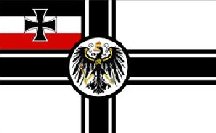
Imperial War Ensign 1903
|
Imperial War Ensign 1903-1919
This was the German War Flag used from 1903 to the end of World War I in 1918. The Kaiser Wilhelm II ordered the design changed in 1902 because he felt it looked too similar to the British White Ensign under certain lighting conditions.
Germany declared war on France in July of 1914 and Russia in August of 1917, coming to the aid of Austria-Hungary.
( Click here to learn more about the history of the Imperial War Flag 1867-1921 ) |
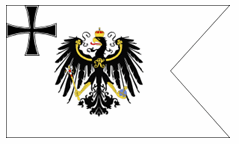
Inland Waters War Ensign
(Top Mast Flag of SMS Preussen)
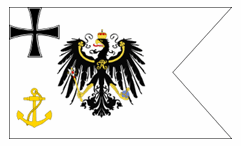
Inland Waterways Service Ensign
|
Imperial Inland Waterways Ensign 1892-1918
This pennant-like naval ensign had several variants with different initials added to either side of the anchor emblem, but they all acted as an Inland Waterways Service Ensign. These dove-tailed flags were also called the "Kingdom of Prussia War and Civil Ensigns" or simply "Royal Ships Ensigns." The eagle used on them was based on the shield design used on the old national flag of the Kingdom of Prussia and was also used on the Imperial German War Ensign.
Although these swallow-tailed ensigns were not ever used on the open seas after 1888, they continued to be used on internal German waters until 1918 as Custom Services and Fishery Service flags. The retangular-shaped Imperial War Ensign with Imperial Coat-of-Arms (as shown directly above) was the only flag used at sea after 1888 until 1919.
An exception to this inland waterways restriction was between the two World Wars when the Inland Waterways War Ensign was used as a top mast flag by the Weimar Republic Battleship "Prussia" (Preussen).
Further variant designs of the Inland Waterways Flags can be found at:
( Flags of Imperial Germany (Second Reich) 1871-1918 )
|
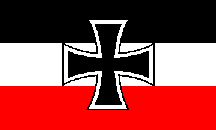
Imperial Naval Ensign
|
German Naval Jack 1903-1919
This was the jack used by all Imperial German warships between 1903 and 1919 and later briefly reintroduced between 1933 and 1935. It was replaced by the swastika type in 1935.
A jack is a flag that looks like the union or canton of a national war ensign (see Imperial War Ensigns above). On warships, the jack is flown from a flag pole (jack-staff) located on the vessel's front end (bow) when at anchor or in port.
|
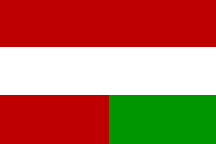
Austro-Hungarian Empire Flag
|
Austro-Hungarian National Compromise Flag 1869-1918
This was the joint Austro-Hungarian flag brought in sometime after the 1867 compromise which gave Hungary home rule. The version more familiar was the joint naval ensign which has crowned shields for Austria and Hungary on it. On June 28, 1914, the assassination of Archduke Franz Ferdinand, heir to the Austro-Hungarian throne, by a "Young Bosnia" assassination team trained in Serbia led to a declaration of war on Serbia by Austria-Hungary. The successful assassination attempt was masterminded by Gavrilo Princip, a Bosnian Serb and member of the terrorist group. |

Austro-Hungarian War Ensign
|
The Austro-Hungarian Naval or War Ensign 1869-1918
This version of the Austro-Hungarian war ensign showed the coat of arms for Hungary and Austria. The hundred and fifty year old Austrian naval ensign was adapted to the new times with the addition of the second coat of arms to represent the Hungarian half of the Monarchy and the green portion of the bottom stripe. The Austrian coat of arms was crowned with the imperial crown and the Hungary coat of arms was topped with the crown of St. Stephen.
Austria-Hungary declared war on Serbia in July of 1914 starting the chain of events that started World War I.
|

Ottoman Turkish Empire
|
The Flag of the Ottoman Empire
Red has been prominent in Turkish flags for 700 years. The star and crescent are Muslim symbols, but also have a long pre-Islamic past in Asia Minor. The basic form of the national flag was apparently established in 1793 under Sultan Selim III, when the green flags used by the navy were changed to a red field with a white crescent and multipronged star on it.
At the beginning of World War I Italy refused to follow her Triple Alliance partners into war and the eventually the Ottoman Turks declared themselves to be members of the central Powers and took Italy's place.
|
| Earlier Wars | Flags of the Central Powers | Flags of the Allies |
Flags of the Allied Powers
United Kingdom - France - Italy - United States

France
|
French Republic Flag 1789-present
Since the first French Revolution the tricolor has been the only official French flag. The colors are basically those of the City of Paris (red and blue) dating from the day of the storming of the Bastille, mixed with the Royal white.
Although it may not be true that in 1789 the Marquis de Lafayette was responsible for inventing the red, white and blue flag, the combinations of Revolutionary and Royal emblems were common at the time. The red and blue of Paris were the livery colors of the city coat of arms and naturally used by the militia.
The original tri-colored flag was created in 1790, but with the colors reversed from what they are today, i.e. with red at the hoist, and revised in 1794 to their modern order.
|

Flag of the Czar
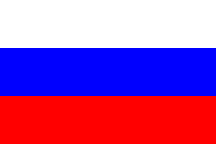
Russian State Flag (type 1)

Russian State Flag (type 2)
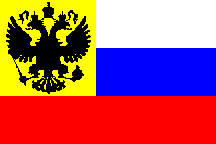
Russian State Flag (type 3)
|
The Imperial Russian Flag 1699-1917
The golden flag with black Romanov coat of arms holding 4 scrolls was used between 1699 and 1917 as the personal flag of the Russian Czar. This flag symbolized the union of the Czar and his people.
The Imperial State Flags 1883-1914
In 1883, the white-blue-red tricolor (type 1), previously the merchant ensign, became the State Flag of Russia, along with a little used (type 2) black-golden-white tricolor flag. Both were replaced in 1914 by a white-blue-red tricolor (type 3) with a canton of the imperial arms. It replaced both the black-orange-white tricolor and the plain white-blue-red tricolor. The new state flag itself disappeared three years later in 1917 when the monarchy was abolished.
The Russian Republic National Flag (type 1) 1917
The Russian Federation National Flag 1997-present
In 1917, the plain white-blue-red tricolor (type 1) became the Russian Republics de facto national flag. However, it was never officially adopted as such, and the short-lived Kerensky government never had time to make it official. Today, after the break-up of the Soviet Union, the white-blue-red striped flag (type 1) has once again become the official Flag of the Russian Federation.
The Imperial State Flag (type 2) 1883-1914
In 1883, the black-golden-white tricolor flag (type 2) in the Romanv family colors, also became the State Flag of Russia, but saw little use.
Russian National Flag (type 3) 1914-1917
The Russian Imperial National State Flag (type 3) is the Russian National flag most used between 1914 and 1917. At that time, in an attempt to link national patriotism and the imperial family, Tsar Nicholas II decreed that a gold square canton be added to the national flag (type 1). On it was the black imperial eagle (in rather simplified form, e.g. no shield on the wings), but still with the central St George shield on its chest. This remained in use until Nicholas' abdication and the declaration of a Russian Republic. Curiously, it continued to fly in Washington D.C. for another 15 years. The United States refused to recognise the Soviet Government, until the beginning of the Roosevelt administration in 1933. Until then, this flag continued to fly over the Russian Embassy in Washington D.C.
|
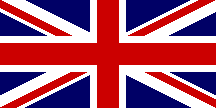
The Union Jack
|
United Kingdom Union Jack
Combines the Cross of Saint Andrew (Scotland) with the Cross of Saint George (England) and the Cross of Saint Patrick (Northern Ireland).
|
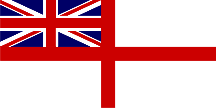
British Naval Ensign
|
Royal Naval Ensign 1864
The White Ensign became the sole ensign of the Royal Navy in 1864. Nelson used the White Ensign at Trafalgar, it replaced the traditional Red Ensign which became the merchant ensign. |

Kingdom of Italy National Flag
|
Kingdom of Italy Flag 1884-1946
The green, white, and red tricolor flag had the Savoy coat of arms on the center white stripe. The coat of arms dated back to the Republic of Noli which used a white cross on a red flag. (Genoa's more famous coat of arms used a red cross on a white field, which was adopted by the Crusaders and England.)
|
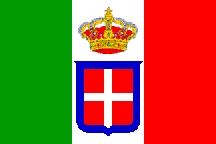
Kingdom of Italy Naval Ensign
|
Italian Naval Ensign 1861-1946
The Royal Italian Navy was born on March 17, 1861, with the merging of the Royal Sardinian Navy, the Neapolitan Army of the Sea and the Navy of the Grand Duchy of Tuscany. The Pontifical Navy would be added in 1871. At the date of its creation, the "Regia Marina" adopted this flag for all warships and merchant ships. This was the flag used by all Royal Italian warships between 1861-1946. While the national flag/civil ensign had the Savoy arms, uncrowned, the naval ensign (Bandiera da Guerra) was different because it had a crown over the arms. |
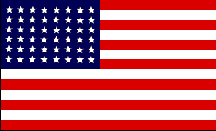
48 Star United States Flag
|
United States of America Flag 1912-1959
In 1912, two stars were added to the United States flag, representing Arizona and New Mexico, bringing the total number of stars to 48. American fighting men would fight under this flag in World War I in 1917 and 1918. |

48 Star United States Jack
|
World War I United States Naval Jack
A jack is a flag that looks like the union or canton of a national flag. For ships of the United States Navy, it is a blue flag containing a star for each state. On warships, the jack is flown from a flag pole (jack-staff) located on the vessel's front end (bow) when at anchor or in port. American fighting ships would display this jack in World War I, World War II, and the Korean War. |
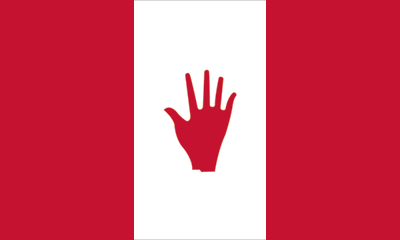
General Goybet´s Field Flag
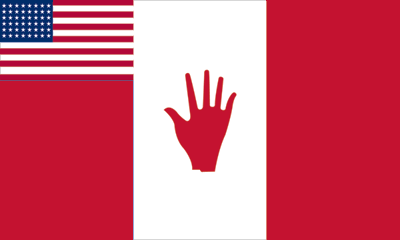
Goybet´s Second Field Flag
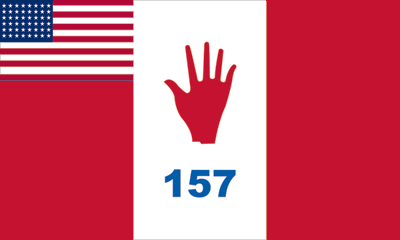
Second Field Flag (variant)
|
The American "Red Hand" Division Flag
When American Black volunteers arrived in France they were separated into special "Black" Regiments during World War I. French General Mariano Goybet commanded the French 157th division which consisted of the French 333rd infantry regiment and the American 371st and 372 regiments.
The first flag that was used by the 157th was the field flag General Goybet. As a General officer he was authorized a personal field flag which would be Red, White, and Red. This flag is mistakenly shown sometimes with a blue stripe near the hoist, similar to the national flag. When the first stories appeared about the now famous Fighting "Red Hand" Division, the flag was called a French flag, which it is, but a French General's field flag, not the National flag of France. In the case of General Goybet and his unit, he added the red hand to the white field to remember the soldiers that had died and to remind the remaining soldiers that there was a blood debt owed, a vengeance if you will, to the Germans for the death of those soldier.
In 1918, the 371st Infantry, a part of the 92nd Division was attached to the 157th to bring the unit to full strength and to fulfill a promise made to France from the long ago debt of the Revolutionary War. Because of this, the General's flag was changed again, this time adding two small American flags (one on each side) to the red stripes closest to the staff, symbolizing the addition of the American unit to the command. Historically, the 372nd was one of the oldest African-American units in the country dating back to the Civil War with a lineage including the Monumental City Guards and the First Separate Company.
Though out the World War I these two African-American regiments fought bravely and were awarded the Croix de Guerre, and several of their men received both the French Legion of Honor and the American Distinguished Service Cross. Freddie Stowers of the 371st was posthumously awarded the Medal of Honor, our nation's highest military award for bravery. |
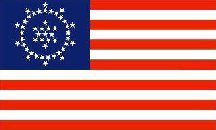
Whipple 48-Star Flag
|
The American History Flag 1917
In 1910, Wayne Whipple proposed a meaningful design should be used for the star pattern of the flag. His idea was that the central 13 stars should represent the original states as on the great seal, then to surround them with a ring of 25 stars representing the states that joined the Union in the first 100 years, and then finally have a ring of ten stars representing the states that joined in the second hundred years. He, at first, called his design a "history" flag and he challenged students who read his book to come up with their own ideas for a meaningful star arrangement.
It is claimed that Whipple's flag design was widely publicized throughout the nation, and approved by President William Howard Taft (very doubtful), but documentation for these claims have not yet emerged. His flag was produced, however, by the Dettra Flag Company who called it the "Peace Flag" to celebrate the end of World War I in 1917.
|
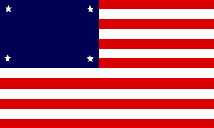
Suffrage Protest Flag
(first seen in 1902)

Women's Suffrage Flag
(first flown in 1917)

19th Amendment Victory Flag
(passed in 1920)
|
National Women's Party (NWP) c1917-1997
Another struggle raged during this period of time, the woman's struggle to get the right to vote in the United States. In 1902, what would become the Women's Suffrage movement created their own version of the Stars and Stripes with only four stars (The American flag had 45 stars at this time) to represent the only four states that allowed women to vote at the time. The flag flew at the podium of the First International Women's Suffrage Conference in 1902. Women from 10 nations attended in Washington, D.C. to plan an international effort for suffrage. Clara Barton is among the distinguished speakers.
A gold-white-purple horizontal tricolor became the flag of the American suffrage movement. In 1913, Alice Paul and Lucy Burns had founded the "Congressional Union for Woman Suffrage", but in 1917 it was renamed The National Woman's Party (NWP). They became the first political group to picket the White House. Their action was viewed as unpatriotic when World War I began in 1917, and they were assaulted, beaten, arrested, and imprisoned. Finally, President Wilson changed his position to support women's suffrage, but, by the time the 19th Amendment was passed in 1920, over a 165 "Suffragettes" had served prison sentences.
As the 19th amendment made its way through the approval process, the NWP sewed a star on their "ratification banner" after each state ratified the amendment. They needed 36. The amendment failed in many states and it came down to the State of Tennessee. On August 18, 1920, the legislature was deadlocked, but suddenly a 24-year old man named Harry Burn changed his vote in a role call. That morning he had received a letter from his mother in which she urged him to do the right thing and vote for suffrage; he did. He was actually chased from the room and had to hide. Upon the news that the struggle was over, Alice Paul unfurled their victory banner and hung it from the balcony at National Woman's Party headquarters in Washington D.C.
Three years later, in 1923, Paul drafted the first Equal Rights Amendment, which was intended to guarantee that equal rights under any federal, state, or local law, could not be denied on account of a person's sex. That struggle still goes on. However, over the next several decades, the National Women's Party authored over 600 pieces of legislation fighting for women's equality; and over 300 of these were passed. In addition, the NWP continued to lobby for the passage of the Equal Rights Amendment until 1997, when the NWP ceased to be a political organization. Today, the NWP acts purely as an educational foundation and runs the Sewall-Belmont House and Museum, located in Washington, D.C.
|
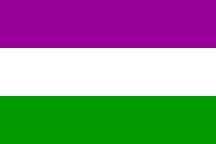
British Sufferage Union 1903
|
Women's Social and Political Union (WSPU) c1903-1917
In the United Kingdom, green, white and purple were the "colours" of the "Women's Social and Political Union," led by Emmeline Pankhurst. The WSPU was considered a very militant organization for its time and campaigned for Women's suffrage in the United Kingdom. It was the first group whose members were known as "suffragettes."
During World War I, the WSPU faded from public attention and was disbanded in 1917. It wasn't until 1928 that universal suffrage for all adults over 21 years of age was achieved in the United Kingdom. The colors of the British Suffragettes' flag was green, white, and violet.
|
| Top of Page| Earlier Wars | Flags of the Central Powers | Flags of the Allies |
|